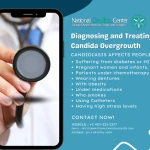Millions of microorganisms, including bacteria and fungi, live inside our body. Some are are good and some are bad. One of such fungus(yeast) that might harm our health is candida. It is a type of yeast that is mostly found in the mouth and gut . Though they are beneficial in moderation, they can upset your body\'s delicate equilibrium if present in excess.
Candida is not harmful when proper circumstances are proper. In fact, our bodies require a specific level of Candida to maintain balance and fitness. Candida communities are kept in check by the probiotic bacteria that live in the body as well as the immune system\'s efforts. However, health problems begin to appear when candida overgrows or when it becomes unmanageable leading to a condition known as "candidiasis". A person may have candidiasis if their immune system is deficient or their healthy probiotic bacteria are subdued.
Most frequently, candidiasis affects people those -
- suffering from diabetes or HIV
- pregnant women and infants.
- patients under chemotherapy
- wearing dentures
- with obesity
- under medications
- who smokes
- using Catheters
- having high stress levels
Only 15 out of 150 identified species of Candida are thought to be associated with Candida infections. The species of Candida that is most frequently linked to candida overgrowth is Candida Albicans. It is the most prevalent type of yeast infection that can affect the skin and other mucous membranes. This kind of yeast infection is rarely dangerous if the immune system is operating properly. However, if the immune system is suppressed and not functioning properly, the candida infection can spread to the bloodstream and tissues around the heart and brain. This can result in significant candida symptoms.
What symptoms indicate Candida?
Depending on the location, type, and intensity of the infection, there are different signs and symptoms of Candida overgrowth. Candidal infection symptoms include:
- Skin infections caused by fungi typically emerge as an itchy, red rash that frequently appears in skin wrinkles. This might lead to nail cracking and discolouration in the toenails.
- Redness, discomfort, cracking, and white blisters in the mouth and tongue are symptoms of oral thrush. This might affect the throat and make it difficult to swallow or chew food.
- Redness, itching, irritation, and white discharge are symptoms of genital thrush. Burning pain and an enhanced sensation to urinate are two symptoms of urethral yeast infections.
- Stomach pain, diarrhea, constipation, bloating, gas, and nausea are common signs of gut disorders due to candida overgrowth.
- headaches, fatigue, and memory issues, although not actual symptoms, are related and occasionally cited.
Therefore, it\'s crucial to visit a physician to rule out any other illnesses and check for a Candida overgrowth. While candidiasis can be unpleasant, itchy, and irritating; it also poses little danger to your general health. It\'s better to treat the infection as soon as symptoms appear, just like you do with any other ailment. Severe infections could spread to other organs of your body, such as your blood, heart, and brain, if candidiasis is not addressed.
How to diagnose and identify Candida overgrowth?
The diagnosis of "candida hypersensitivity" is not supported by science. It should be kept in mind that having Candida in our bodies is natural; an issue arises when there is an overgrowth of Candida. A physician will first inquire about your symptoms, such as their severity and duration of suffering. He could suspect Candida overgrowth on visual indicators like skin rashes and fungal infections, such as recent antibiotic usage, excessive stress, and a high-sugar, high-carb diet.
An examination of the affected area can be conducted to make a diagnosis based on your symptoms, lifestyle and medical background. Skin, nail, excrement, mouth swab or blood samples may be taken and examined under a microscope. These samples can also be analyzed to check if Candida grows when these are placed in a fungal culture.
A camera can is inserted down the throat and is typically used to diagnose Candida overgrowth in the esophagus. Occasionally, a tissue specimen (biopsy) is obtained during this process in order to examine the existence of Candida.
To determine what forms of yeast may be overgrowing in your GI tract, the most popular test for Candida overgrowth is a stool analysis. The stool test indicates the quantity of various forms of yeast that were discovered in your feces. A result between one and two denotes a normal level of yeast, whereas a reading between three and four denotes overgrowth.
Self tests can also be performed at home to diagnose the Candida overgrowth.To know more about the type of tests please make a move to Candida alternative treatment center, Florida.
Candida overgrowth can also compromise your gut\'s lining, increasing gut permeability and resulting in leaky gut syndrome, a dangerous disorder where germs from the gut can enter your bloodstream. In fact, the symptoms of both disorders frequently co-exist, and many of the symptoms of Candida overgrowth resemble those of leaky gut syndrome.
Once we identify what needs to be addressed and healed based on the severity of the infection, we can design a Leaky gut natural remedy program or Candida overgrowth natural cures program that will focus on restoring yeast balance, and supporting the gut lining, as there was likely damage caused by the yeast overgrowth.
If you\'re still perplexed, contact Leaky Gut Natural Treatment in Florida to get answers to all of your questions. Don\'t put your health at risk. "Health is Wealth."



